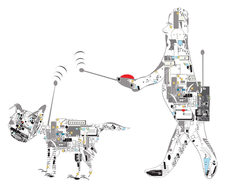Control your Android smartphone from your desktop
Remote Control

© Lead Image © victor kuznetsov, 123RF.com
With guiscrcpy graphical user interface and the scrcpy command-line tool, you can control your smartphone from the comfort of your Linux desktop and even record what you're doing onscreen.
Smartphones and the Linux desktop complement each other quite well thanks to cloud services. If you're not afraid of Google services or providers like Dropbox, WhatsApp, and the like, you never again have to connect your mobile phone to your computer to synchronize data or copy photos and videos. Even messengers like WhatsApp or Google's Messages now offer a web interface so that your mobile phone can stay in your pocket.
However, there are also situations in which you might want to be able to use your PC to operate your mobile phone. Ideally, you would want to transfer the content of the mobile phone display to the PC desktop. This is exactly what the duo of the scrcpy command-line program and the guiscrcpy graphical user interface (GUI) offers. These open source programs available for Linux, macOS X, and Windows even let you record what is happening on the mobile phone display.
Screen Copy
scrcpy comes from the Genymobile [1] treasure trove. Among other things, Genymobile specializes in virtualizing Android, which means that developers can test their applications on a variety of smartphones or tablets without having to own the devices themselves. As a command-line tool, Genymotion provides the scrcpy [2] program's source code on GitHub for download under the very liberal Apache license.
[...]
Buy this article as PDF
(incl. VAT)
Buy Linux Magazine
Subscribe to our Linux Newsletters
Find Linux and Open Source Jobs
Subscribe to our ADMIN Newsletters
Support Our Work
Linux Magazine content is made possible with support from readers like you. Please consider contributing when you’ve found an article to be beneficial.

News
-
Two New Distros Adopt Enlightenment
MX Moksha and AV Linux 25 join ranks with Bodhi Linux and embrace the Enlightenment desktop.
-
Solus Linux 4.8 Removes Python 2
Solus Linux 4.8 has been released with the latest Linux kernel, updated desktops, and a key removal.
-
Zorin OS 18 Hits over a Million Downloads
If you doubt Linux isn't gaining popularity, you only have to look at Zorin OS's download numbers.
-
TUXEDO Computers Scraps Snapdragon X1E-Based Laptop
Due to issues with a Snapdragon CPU, TUXEDO Computers has cancelled its plans to release a laptop based on this elite hardware.
-
Debian Unleashes Debian Libre Live
Debian Libre Live keeps your machine free of proprietary software.
-
Valve Announces Pending Release of Steam Machine
Shout it to the heavens: Steam Machine, powered by Linux, is set to arrive in 2026.
-
Happy Birthday, ADMIN Magazine!
ADMIN is celebrating its 15th anniversary with issue #90.
-
Another Linux Malware Discovered
Russian hackers use Hyper-V to hide malware within Linux virtual machines.
-
TUXEDO Computers Announces a New InfinityBook
TUXEDO Computers is at it again with a new InfinityBook that will meet your professional and gaming needs.
-
SUSE Dives into the Agentic AI Pool
SUSE becomes the first open source company to adopt agentic AI with SUSE Enterprise Linux 16.

